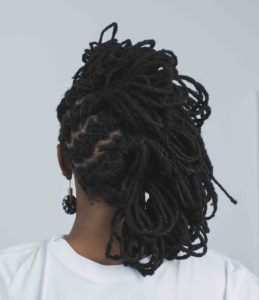This question comes up regularly at Tribus Urbaines.
To answer it, here is an overview of the different dreadlock techniques and our opinion on the most appropriate ones for your given hair type and lifestyle.
A few reminders before getting starting:
- Dreadlocks are done on natural hair, not on straightened hair.
- It’s best not to be prone to dandruff or other scalp problems. It’s complicated to treat scalp problems without weakening the dreadlocks and slowing down the locking process (especially using the twist technique). In the case of abundant dandruff, flakes risk sticking to the locks and making them look poorly cared for.
- In the case of severe alopecia, it is best to wait until the hair grows back and becomes stronger because the weight of the locks could worsen the situation.Twist, crochet or needle: which of these methods is best for you?
The twist method
Advantages?
- This technique promises healthy and resistant locks lasting many years
- It results in flexible locks that are harmoniously shaped
- The length of your natural hair is not shortened by the locking process
Disadvantages?
- Locks are not instantaneous – the process takes longer than other techniques.
- Shampoo can be done once a month only, while the locks mature (4 to 6 months).
The Twist method is most suitable for afro curly and frizzy hair.
The technique is difficult to use on non-afro curly or frizzy hair because it takes longer to mature and may not work at all because of the hair’s soft texture. This technique cannot be used on straight hair.
How to start locks with a twist?
On clean and damp hair and scalp, start the twist process by choosing the outline (square, triangular or staggered) and the desired size. Using a metal comb, pancake each section of hair and apply a small amount of gel. Wrap the section of hair tightly around the comb. At first glance, this creates the appearance of a finger coil. Secure each section with metal tweezers because sometimes the lock of hair can come loose. Once the process is complete on every section of the scalp, leave it to dry under the heater for 30 min. Once dry, it is important to make a protective hairstyle so that the locks can take on shape and volume without being disturbed by water or other friction. Do not shampoo for one month, allowing the locks to take on their basic form before the 1st tightening.
Tightening the twist?
To tighten, the process is the same although shorter because the outline is already established. Start with 2 gentle shampoos (minimum), then comb each section of hair, dry it and make a protective hairstyle.
This tightening process will have to be done 4 to 6 times before obtaining mature dreadlocks.
It is possible to tighten your already mature locks with the twist technique even if they were created using another technique. The twist technique is the best approach for ensuring healthy locks that won’t break or fall.
Maturation time is 4 to 6 months. The tighter the curls, the faster the locks will mature.
What to avoid?
- Avoid getting your locks wet, outside of shampooings, for the first 4-6 months.
- Avoid wool hats or scarves, which can leave residue in the locks, which is difficult to remove without having to untangle them entirely, delaying the formation process.
- Avoid taking off your protective hairstyle too soon.
- Avoid using creams, waxes, butters or conditioners. Use only a mild shampoo to wash, natural oils (non-solid liquids) to nourish, and a moisturizing gel for twist tightening. Any other product will leave residue inside the locks.

The crochet method
Advantages?
- This technique allows you to have instant locks, unlike the twist technique.
Disadvantages?
- You could lose a few centimeters in length
- Your locks may be less harmonious and smooth in appearance, with possible size differences and bumps
- You will have less flexible locks than with the twist technique
- There is a risk of the locks splitting or eventually falling with this technique.
This technique can be used on all hair textures but is recommended especially for softer curly hair and straight hair.
How to start dreadlocks with the crochet method?
On DRY hair and scalp, start the crochet process the same as the other techniques, by choosing the outline (square, triangular or fifth) and desired size. Start by crimping each section of hair and then with a hook, use the “interlocking” technique, which is to pass the locks through the root. Repeat this process horizontally and vertically until the root is tight. Then repeat the same process inside the locks themselves.
Once this process is complete on each section, shampoo (2x minimum) and let the locks dry for 30 min. A protective hairstyle is not mandatory because the locks are already formed.
Use the needle to polish your crochet locks, giving them more hold and shape.
The process is the same for tightening. Tighten the locks on dry hair using the hook at the root, then shampoo and dry.
Maturation time
The locks are instantaneous. They will grow in mass and length over time but the bulk of the work is done when the locks start.
What to avoid?
- Don’t wash too frequently. It’s advisable to wash mature locks every two weeks (not more frequently). Water and friction weakens the locks.
- Don’t use creams, waxes, butters or conditioners. Use only a mild shampoo to wash as well as natural oils (non-solid liquids) to nourish and a moisturizing gel for twist tightening. Any other product will leave residue inside the locks.

The Needle method:
Advantages?
- This technique gives you instant locks, unlike the twist technique.
Disadvantages?
- Very rigid and smooth looking dreadlocks (less natural)
- A very long and expensive process.
This technique can be used on all kinds of hair, but is mostly recommended for softer textures – curly and smooth.
How to start the Needle lock process?
On DRY hair and scalp, start the crochet process just like the other techniques, by choosing its outline (square, triangular or fifth) and desired size. Start by crimping each section and then take your needle and create small knots by turning the section from left to right by going back and forth with the needle.
Once this process is completed on each section, shampoo (2x minimum) and then let the locks dry for 30 min. A protective hairstyle is not mandatory because the locks are already formed.
Needle tightening
The process is the same for tightening. Tighten the locks on dry hair using the needle at the root, then shampoo and dry.
Maturation time
The locks are instantaneous, they will grow in mass and length over time but the bulk of the work is done when the locks start.
What to avoid?
- Don’t wash too frequently. It’s advisable to wash mature locks every two weeks maximum, not more often. Water and friction weaken the locks.
- Don’t use creams, waxes, butters or conditioners. Use only a mild shampoo to wash as well as natural oils (non-solid liquids) to nourish and a moisturizing gel for twist tightening. Any other product will leave residue inside the locks.
To choose the best technique for you, come discuss it with one of our Lockticiennes (Stelly in Geneva or Isabelle and Merveille in Lausanne) at your next consultation appointment.






